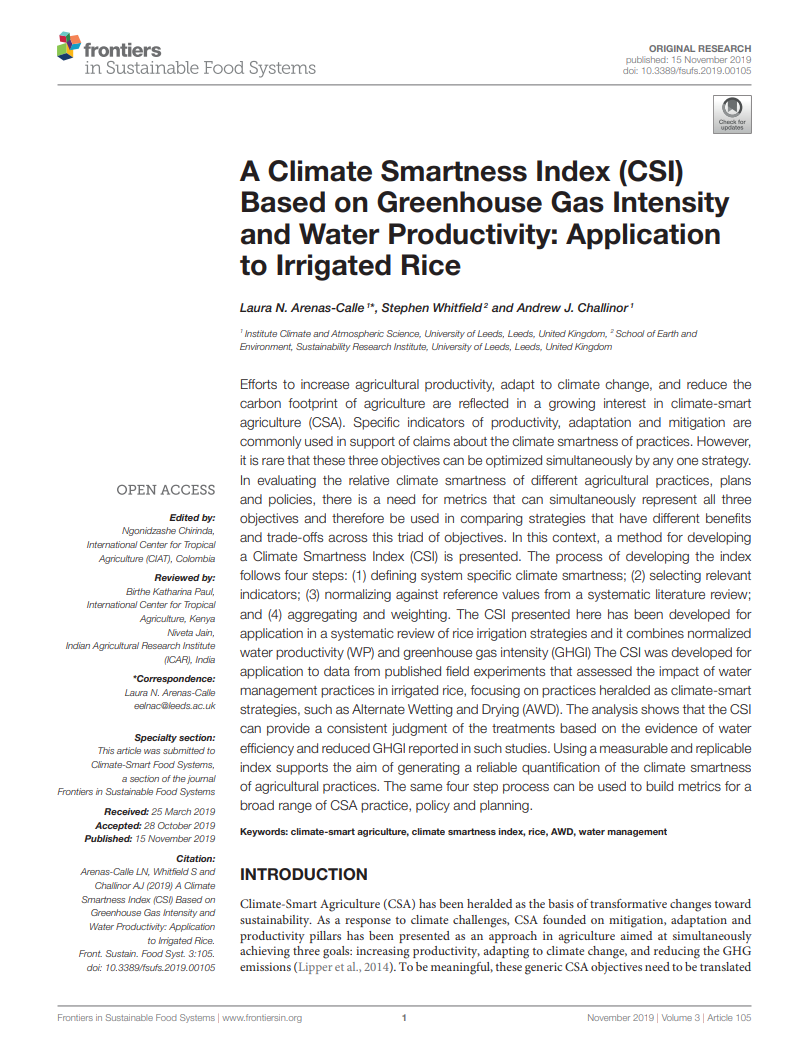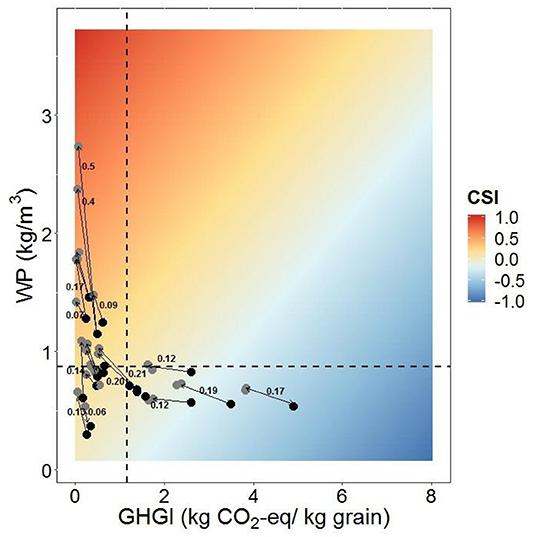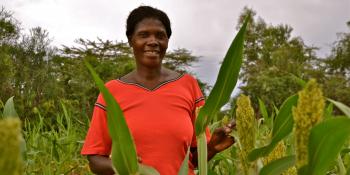Climate-smart metrics for irrigated rice

New journal article uses emissions intensity and water productivity to assess the climate-smartness using a Climate-Smartness Index.
Since its launch by the Food and Agriculture Organization of the United Nations (FAO) in 2010, the climate-smart agriculture (CSA) approach has been supported by a large body of evidence that demonstrates how adequate agricultural management can promote sustainable agriculture under climate change scenarios.
The literature on CSA focusses on clear objectives that can be applied to all agricultural systems like "sustainably increasing agricultural productivity and incomes; adapting and building resilience to climate change; and reducing and/or removing greenhouse gas emissions, where possible."

The CSA approach has been clearly conceptualized, for example through the well-known CSA pillars (mitigation, adaptation, and productivity). However, the “climate-smartness” of agricultural systems that use CSA practices is more complex to determine. This is due to the fact that the climate-smartness of a system varies according to adaptation and mitigation priorities, agro-climatic conditions and climate risks, among others.
For instance, water-saving irrigation technologies are highly encouraged in rice fields prone to water scarcity. However, clayey soils are more suitable for such practices than sandy soils, since there they are likely to lead to greater water savings without yield penalties. Similarly, during the dry season, water scarcity might be a priority issue, but this changes during the rainy season when the main issue might be methane production by prolonged waterlogging.
Thus, defining “when” and “how much” a practice contributes to the climate-smartness of an agricultural system is important to support the assessment and monitoring of climate-smart technologies. In addition, the collection of this information contributes to the systematic reporting of evidence, facilitating global analyses and spatial-temporal comparisons.
Design of a Climate-Smartness Index (CSI)
To contribute to the reliable and replicable assessment of climate-smart technologies, a methodological framework for the designing of Climate-Smartness Indices (CSI) was proposed. This work was presented in a recent journal article titled: “A Climate Smartness Index (CSI) Based on Greenhouse Gas Intensity and Water Productivity: Application to Irrigated Rice”.
The framework followed the structure of a generic composite index design. First, a conceptual framework based on the definition of climate-smartness for irrigated rice was developed. Next, indicators to represent such climate-smartness were selected. Finally, the weighting and aggregation of the indicators were decided.
The resulted CSI aggregates normalized indicators of Water Productivity (WP) and Greenhouse gas intensity (GHGI), equally weighted, to represent the inverse relationship between WP and GHGI.

Figure 1. Scatterplots of the relationship between Greenhouse Gas Intensity (GHGI) and Water Productivity (WP) plotted over a heat map indicating CSI values. Source: Arenas-Calle et al (2019)
The CSI uses a scale between -1 to 1, where negative values indicate lower climate-smartness due to high GHGI, low WP or both. On the contrary, values close to 1 are associated with high climate smartness, which can be associated with low GHGI, high WP or both. The CSI presented here offers a novel contribution to the growing body of literature on CSA by providing a single quantifiable metric of climate-smartness.
Future developments of this work may focus on the development of equivalent metrics for application in other agricultural systems and contexts, contributing to the building of a replicable and comparable evidence base for CSA practices and planning.
Comparing of Alternate Wetting and Drying (AWD) and Continuous Flooding
To test the CSI, published data of paired comparisons between AWD and continuous flooding treatments were used. Studies that reported N2O and CH4 emissions, total water input, and yield were used to calculate the CSI.
In all the experiments selected in this study, the AWD treatment reached higher scores than continuous flooding treatments, due to increased water productivity, a reduction of GHG emissions, or both (which achieved the highest CSI scores in this study). Moreover, the CSI allowed comparing different studies under a normalized scale, which helps to size the AWD treatment performance under different conditions.
The creation and application of the CSI illustrate that climate-smartness is a dynamic concept and depends heavily on the temporal and spatial context in which climate-smart practices are applied.
Read more:
- Blog: ‘Climate-smart agriculture’ is turning 10: is it time to celebrate?
- Blog: The way forward for climate-smart agriculture
- Research highlight: Innovation platforms: key spaces for CSA implementation
Laura Arenas-Calle is a PhD Student from the University of Leeds with a scholarship from CCAFS.



